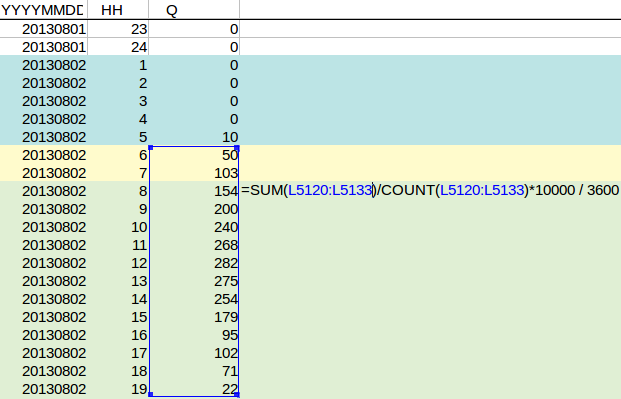How to calculate the daily average radiation: Difference between revisions
Jump to navigation
Jump to search
No edit summary |
No edit summary |
||
| Line 9: | Line 9: | ||
[[File:Tutorial_daily_avg_radiation_(Heat_Overlay).png]] | [[File:Tutorial_daily_avg_radiation_(Heat_Overlay).png]] | ||
{| class="wikitable" | |||
! Column | |||
! Name | |||
! Unit | |||
! Dutch Description | |||
|- | |||
|2/B | |||
|YYYYMMDD | |||
|Date | |||
|''datum (YYYY=jaar,MM=maand,DD=dag)'' | |||
|- | |||
|3/C | |||
|HH | |||
|Hour | |||
|''tijd (HH=uur, UT.12 UT=13 MET, 14 MEZT. Uurvak 05 loopt van 04.00 UT tot 5.00 UT'' | |||
|13/L | |||
|Q | |||
|J/cm2 | |||
|''Globale straling (in J/cm2) per uurvak;'' | |||
|} | |||
{{article end | {{article end | ||
|notes= | |notes= | ||
Revision as of 15:30, 16 February 2023
The daily average radiation is measured for the hours the sun is up. It is up for discussion to take into account the first and last hours, because these hours often don't contribute fully to the average. Similar to the hourly radiation, the radiation values from KNMI weather data column Q have to be multiplied:
,
where:
- is the first full hour with sun radiation.
- is the last full hour with sun radiation.
| Column | Name | Unit | Dutch Description | ||||
|---|---|---|---|---|---|---|---|
| 2/B | YYYYMMDD | Date | datum (YYYY=jaar,MM=maand,DD=dag) | ||||
| 3/C | HH | Hour | tijd (HH=uur, UT.12 UT=13 MET, 14 MEZT. Uurvak 05 loopt van 04.00 UT tot 5.00 UT | 13/L | Q | J/cm2 | Globale straling (in J/cm2) per uurvak; |



